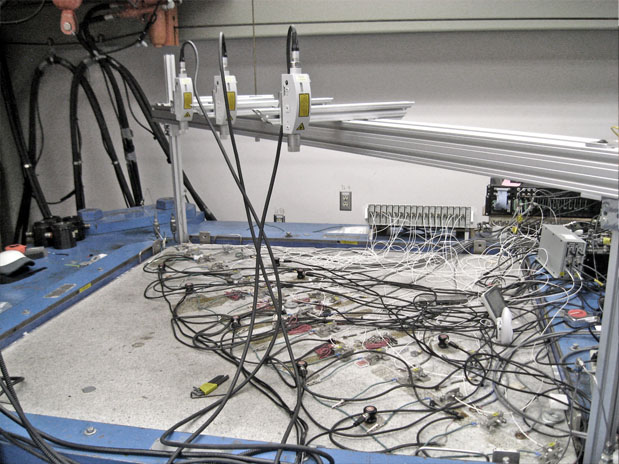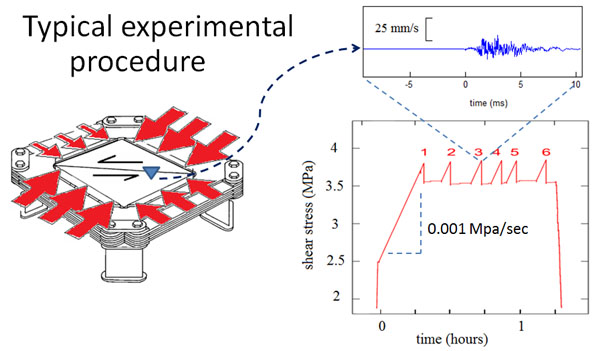Foreshocks and earthquake nucleation project
A key question in earthquake science is: "How do earthquakes begin?" Laboratory experiments, theoretical arguments, and numerical models all indicate that earthquakes begin relatively slowly in a process referred to as earthquake nucleation.
In this project, we study the initiation of stick-slip on a simulated fault which is cut through a large laboratory specimen as an analogue for earthquake nucleation. This research was conducted on a large-scale biaxial earthquake apparatus at the USGS in Menlo Park, California. This unique facility (shown below) is the largest of its kind in the world. Made in the 1970s by Jim Dieterich and Quentin Gorton, the apparatus can accommodate samples 1.5 m by 1.5 m by 0.4 m in size and can apply over a million pounds of force (through the steel loading frame shown in blue) to a 2 m long fault cut diagonally through the Sierra White granite sample.

In the last twenty years, the instrumentation on the laboratory sample has been improved, thanks to Brian Kilgore. The laboratory sample is instrumented with arrays of slip sensors and strain gages which are used to measure local fault slip and stress changes at many locations along the fault. In this large scale experiment, one part of the fault may begin to slip while another part remains locked. The simulated strike-slip fault is highlighted in yellow in the picture below. My contribution has been to install the laboratory equivalent of a seismic network to the sample (an array of 15 Piezoelectric sensors) which is used to quantify the ground motions due to seismic waves radiated from the fault when it ruptures in a stick-slip event and to detect tiny foreshocks and aftershocks that are radiated from the fault when it slips slowly during nucleation and as afterslip.

In a typical experiment, we increase the hydraulic fluid pressure in four flatjacks that surround the granite sample. This increases the normal stress on the simulated fault. Then, by means of servo control, we slowly increase the pressure in two of the flatjacks while decreasing the pressure in the other pair of flatjacks. (The force that the flatjacks apply to the sample is illustrated with red arrows in the picture below.) This causes the average normal stress on the fault to remain constant (typically at 5 MPa) while shear stress on the fault increases at a rate of 0.001 MPa/sec. We slowly load the fault in this way for about 15 minutes until suddenly the fault slips in stick-slip fashion and the shear stress drops. Each stick-slip event is numbered in the graph below.) While the slip from a typical stick-slip event is too small to see (about 100 microns), it occurs so rapidly that it can be easily heard. (It sounds a bit like a book drop or a shot from a gun.) The rapid fault slip generates seismic waves that propagate throughout the specimen and are recorded with the piezoelectric sensors.

Just before the stick-slip instability, we often detect some slow but accelerating slip on one section of the fault. Tiny foreshocks are sometimes produced from within this slowly slipping zone. The ground motions from the foreshocks are recorded by many different piezoelectric sensors located both on the top (blue traces below) and bottom (black) surfaces of the sample. We use the P- and S-wave arrival times to triangulate the source locations, and we use the amplitude and polarity of the waveforms to identify the focal mechanisms of these tiny earthquakes.

More information can be found in the following publication:
McLaskey, G. C., Kilgore, B. D, Lockner, D. A., and Beeler, N. M. (2014) Laboratory generated M -6 Earthquakes, Pure and Applied Geophysics DOI 10.1007/s00024-013-0772-9 pdf
McLaskey, G. C., and Kilgore, B. D (2013) Foreshocks during the nucleation of stick-slip instability, Journal of Geophysical Research 118, 2982-2997.pdf